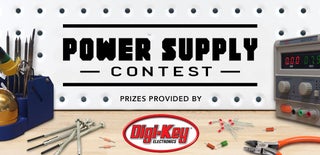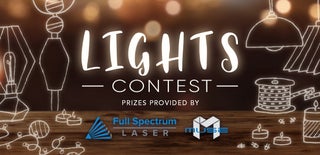Introduction: $10 LED Shop Light
I went into a certain Big Box Club store and saw what seemed like the perfect idea. LED shop lights! What shop doesn't need more light, right? But upon closer inspection I saw that these $40 lights were little more than two plastic tubes with a single row of LED strip lights in each. I had done several projects with these types of lights and I knew how cheap they were and I thought, "Heck I could build 4 sets of lights for the price of these". So that is what I set out to do
In the end I have a light that is brighter, uses less energy, is in the color spectrum that works best for me and cost WAY less. OH, and I can smugly say "Oh that? Oh, I just whipped that up one morning" ;-)
Step 1: Gather Your Materials
Components:
- 1 Basic Two by Four. I found the cheapest thing that Big Orange had. They called it simply Whitewood. This is decent if not pretty wood that is used for "unseen" areas in construction.
- 1 Can of White Paint.
- 1 Roll of LED Strip Lights. I used indoor (non waterproof)
- 1 Power Adapter for the LED lights
- Some wire. I used Red and Black to follow traditional power color codes.
Hanging Hardware:
- 2 Eye screws. I used two inch because I already had some from a previous project.
- 1 Roll of paracord or other strong cord like material.
- 2 Ceiling Hooks.
- 2 Pulleys (You could probably get away with just using the hooks as the "pulley").
- 2 D Clips (Optional. I had some already so.... )
- 1 Double Ceiling Hook.
Tools:
- Circular Saw or Table Saw
- Wood Glue
- Glue Gun w/glue sticks
- Soldering Iron w/Flux Core Solder (fairly thin)
- Nail Gun w/Air Compressor (Optional)
- Clamps (Optional)
- Wire cutters or Scissors
Step 2: The PLAN
The basic premise of my shop light is this. Cut two 1/4" slices off of the 2x4. Then make two angled cuts along the remaining piece. Then attach those two thin cuts as "wings" to make the body of the light. Thus making it resemble traditional fluorescent two bulb shop lights!
- Plug in your light strip first to make sure it all works. Ok, now take it apart and lets get to it.
- Make two cuts of 1/4" off of the long edge of the 2x4
- Make two diagonal cuts down either side of the 2x4. In my first version I tried it at 45 degrees but that seemed too steep to me. In this version I made the cuts at 30 degrees.
- Put wood glue on the wings and adhere them to the main body. I used a nail gun to hold them in place. If you don't have one I suggest using clamps. Then cut or sand off any overhanging parts. Or don't! It's not like you will be able to see that part when it's all done.
- Paint. I used a high gloss white for its reflective properties but its your light, choose the color that you feel fits the proper mood for your shop.
- Peel and stick your LED light strips. Start on the outside edge on one side and then do the opposite side. This will allow you to easily space out the remaining two strips. Remember to cut ONLY on the marked cut lines.
- Figure out how many pairs of wires you will need. Then cut and them to size and strip. NO NOT YOU, the wires! Then tin the wires and your contact points on the strips. (Tining means to heat them up and add a small amount of solder to them before you actually solder the two parts together)
- Solder + to + and - to -. No wires or connections are used at the end of the strip.
- Solder the leads to the power adapter and route them around the end of the body and to the top of the light.
- Use hot glue to tack down the wires so they don't get in the way. Also hot glue is non conductive and I use it as an insulator to protect the solder points. Lastly also tack down the lights every six inches or so. The glue on the back of these strip lights can get weak over time.
- Screw your eye screws into the top of the light about one inch from the end. Make sure not to go all the way through. You may need to pre drill these spots. Make sure not to hit your lights or wires.
- Measure (guestimate) how much cord you will need and then cut to length. If you are fancy like me tie one end on each cord to a D clip or mini carabiner and then attach to the eye screws.
- Guestimate (measure) how far apart the eye screws are and then mark out on the ceiling the spots where your two ceiling hooks need to go. Again it might help to pre drill these spots. Screw your hooks in finger tight.
- Again, if you are going the "fancy" route, thread your cord through your pulleys first, before hanging them. Makes it way easier. [Pro Tip, after threading them through the pulleys I tied a medium sized nut to the end of each cord to keep them from accidentally getting pulled out of the pulley]
- Hang each of your pulleys on the hooks.
- Screw the Double Ceiling Hook to the wall. Yeah, I know, trust the bear, he knows his hooks.
- Plug in your light strip to the power adapter and hoist your light to the height you want.
- Tie off your cords to the double hook on the wall. I tied the end of my cords together so I could just loop them under the hooks.
- Plug in your power adapter and bask in the unearthly glow!
Step 3: Assembly
Ok, we are going to assume that you were able to make the desired cuts and still have all your digits. Yes? No? Ok, Stubby, let's get back to it.
Here you can see that we are laying out the LED strips. Again, only cut on the lines that say "Cut" or have the little picture of scissors. I suggest laying out the two outside strips first as it makes it easier to space things out evenly.
Step 4: Wire It UP, Wire It UP, Wire It UP!
Bonus points if you get the Avian film reference ;-)
Anyway, always remember, measure twice, cut once. Then say "Awwww #$@&" and toss it then try again. A wire cutter/stipper makes this job much easier but simple scissors could be used. Also a few pieces of shrink tube will make it last longer and give it that professional look that says "I have a heat gun and I'm not afraid to burn myself with it."
Step 5: Things Are Looking UP.
I'm a dad and bad puns are like the breath of life for dads.
Attach your bolts. Again, predrill if you think your wood will split. Trust me, it probably will. Attach your clips, hook up the pulleys and hoist away.
I bet right about now you are thinking "OH, that's what he's doing with the double ceiling hook". See! Red>Average Bear.
And the best thing about this project. Is that once it's done, installed and turned on.... You can't see any of the screw ups you made while building it. All you can see are those brilliant LED lights. And then spots, lots and lots of spots.
Cheers!
Red
Step 6: ALEXA, Shop Lights On!
Time for the icing on the cake. I ended up routing the power adapter for this over to the same plug in the ceiling that my garage door opener uses. But now how to turn it off and on? Easy, I just added a $15 WiFi smart plug that is compatible with my Amazon Echo (Don't tell me that you don't have an Echo in your shop? Barbarian!)
Now I just say "Alexa, Shop Lights ON!" as I walk into my kingdom, um, garage. As to the Echo in my shop? You need to consider adding one to yours. And here is why...
- Alexa, set timer for 20 minutes (Paint/Glue drying time)
- Alexa, how many mm in 27 inches?
- Alexa, read my audio book
- Alexa, play music
- Alexa, set alarm for 8:30pm (Time to quit and put the cubs to bed)
- Alexa, turn off shop lights
- Alexa, what is Pi?

Participated in the
Power Supply Contest

Participated in the
Internet of Things Contest 2017

Participated in the
Lights Contest 2017










